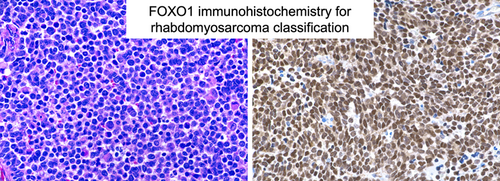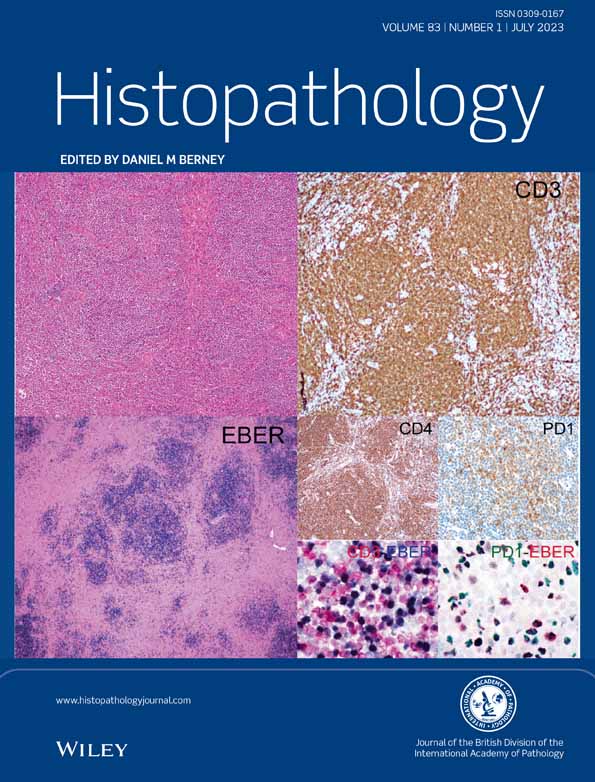Diagnostic utility of FOXO1 immunohistochemistry for rhabdomyosarcoma classification
Abstract
Aims
Rhabdomyosarcomas currently are classified into one of four subtypes (alveolar, embryonal, spindle cell/sclerosing, or pleomorphic) according to their morphological, immunohistochemical, and molecular genetic features. The alveolar subtype is characterised by a recurrent translocation involving PAX3 or PAX7 and FOXO1; identification of this translocation is important for appropriate classification and prognostication. In this study, we aimed to explore the diagnostic utility of FOXO1 immunohistochemistry for rhabdomyosarcoma classification.
Methods/results
A monoclonal antibody targeting a FOXO1 epitope retained in the fusion oncoprotein was used to study 105 rhabdomyosarcomas. FOXO1 was positive for expression by immunohistochemistry in all 25 alveolar rhabdomyosarcomas, with 84% showing diffuse expression in greater than 90% of neoplastic cells; the remainder of alveolar rhabdomyosarcomas displayed at least moderate staining in a minimum of 60% of lesional cells. Apart from three spindle cell rhabdomyosarcomas showing heterogeneous nuclear immunoreactivity in 40–80% of tumour cells, the 80 cases of embryonal, pleomorphic, and spindle cell/sclerosing rhabdomyosarcoma were negative for FOXO1 expression (96.3% specific) when using a threshold of nuclear staining in 20% of neoplastic cells to determine positivity. Variable cytoplasmic staining was present in a fraction of all rhabdomyosarcoma subtypes. Nonneoplastic lymphocytes, endothelial cells, and Schwann cells also showed variably intense nuclear anti-FOXO1 immunoreactivity.
Conclusion
Taken together, our findings suggest that FOXO1 immunohistochemistry is a highly sensitive and relatively specific surrogate marker of the PAX3/7::FOXO1 fusion oncoprotein in rhabdomyosarcoma. Cytoplasmic immunoreactivity, expression in nonneoplastic tissues, and limited nuclear staining of nonalveolar rhabdomyosarcomas represent potential pitfalls in interpretation.
Graphical Abstract
Alveolar rhabdomyosarcoma is characterised by an oncogenic translocation involving PAX3 or PAX7 and FOXO1; identification of this translocation is important for diagnostic classification. This study suggests that among rhabdomyosarcomas, FOXO1 immunohistochemistry is a highly sensitive and relatively specific surrogate marker of the PAX3/7::FOXO1 fusion oncoprotein.
Conflict of interest
The authors declare no potential conflicts of interest with respect to the research, authorship, and/or publication of this article.
Open Research
Data availability statement
The data that support the findings of this study are available from the corresponding author upon reasonable request.





